The Family
Hi Everyone,
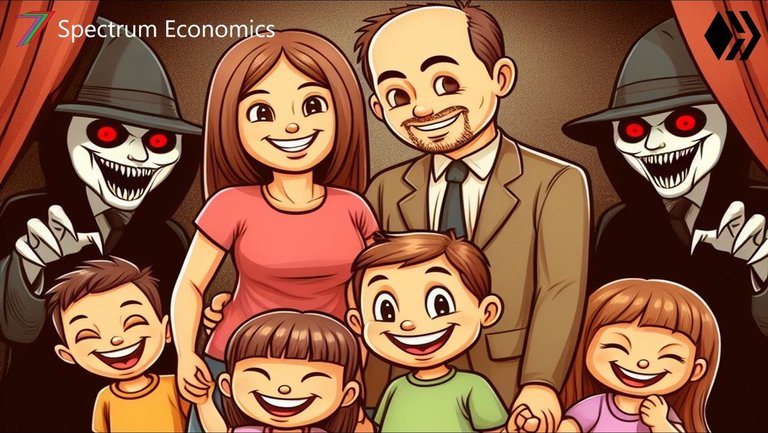
Image Source: Assisted by Bing AI
This post was intended to be part of my ‘Playbook’ series. However, it has turned into a more general discussion regarding the family and influences on it, based partly on theory and partly on statistics. I tend to revisit this subject matter again based on my conclusions in the final two sections of this post.
Family is a Natural Phenomenon
Humans are not the only species of animals to live in families. Many mammals and birds have their own family structure. Such animals include elephants, wolves, lions, dolphins, orcas, otters, chimpanzees, crows, and emperor penguins (Treehugger and Wildlife Informer). The structure of these families can vary considerably (e.g., elephants living in groups of females or wolves where the parents and a few other adults take care of the puppies), but they all serve similar purposes. They all provide these species with the best opportunities to survive and thrive. Families appear to be the most important to intelligent species. Almost all the most intelligent species have a family structure. Therefore, it is logical that humans, the most intelligent species, also have a family structure.
Factors Influencing Family Structure
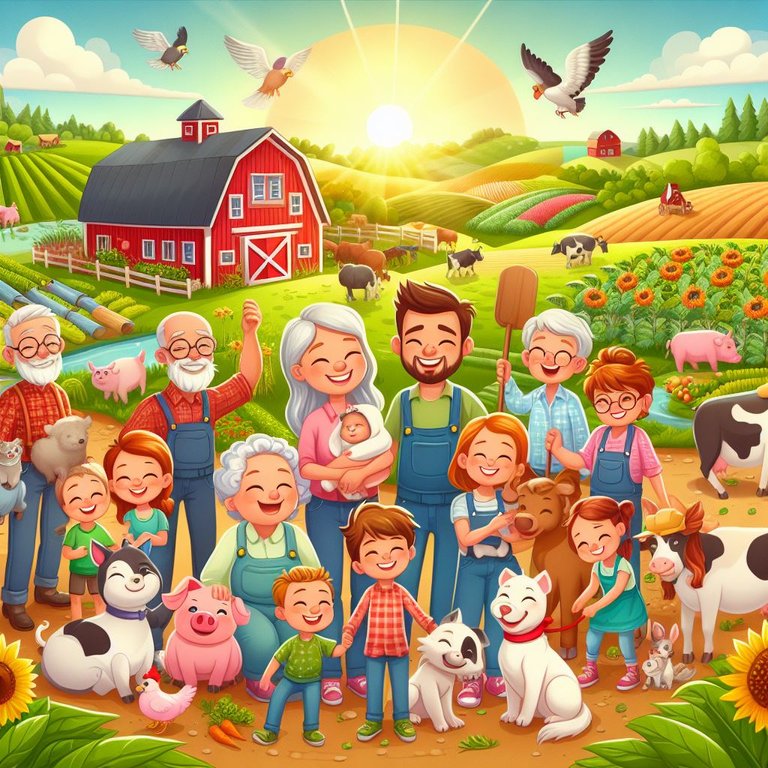
Image Source: Bing AI
Human family structures can vary considerably. Several key factors might determine this structure. These could be culture, values, religion, wealth, wages, location (i.e., urban vs. rural), and the standard and availability of healthcare. For the purpose of this post, family will only refer to family members living in the same household.
Culture is a huge determinant of that structure. Western cultures tend to have smaller family structures. Whereas, Asian and Hispanic cultures tend to have larger family structures that are more likely to include extended family (Statista).
One of the earliest influences on family was religion. For example, the Bible describes a family as the union of one man and one woman in marriage for producing and raising children until they reach adulthood (Got Questions). It encourages large nuclear families. Historically, many predominantly Catholic countries tend to have larger families. For example, European countries with a higher percentage of Catholics have larger households (CEO World). See data for Poland, Spain, Italy, and Ireland.
Muslim families also tend to be bigger. Children are encouraged not to leave the family until they start a family of their own. Before that, they are expected to look after their parents (About Islam). This practice is supported by data (Pew Research Center).
Rural-urban migration has affected the size of the family. When societies were predominantly agrarian, large families were considered an advantage. Having children was beneficial. They could contribute to the family and farm. They could help raise their younger siblings.
There was less scarcity of land, and bigger families could be easily accommodated on larger properties. Adults did not need to be geographically mobile as they worked the land where they lived. This also meant they did not need to move away from their parents.
People living in the city are often employees rather than self-employed (Belloc, J., et al). Thus, they have a greater need for geographic mobility. This makes it more difficult to have an extended family. Children cannot contribute to the work of an employee. Land and property in the city are scarce. Family size is restricted by the size of the available accommodation. Countries with the highest percentage of people living in urban areas also have the smallest households (CEO World for household size and the Global economy for percentage rural population).
Availability and standard of healthcare play a role in determining family size. There is a correlation between a high infant mortality rate and larger families (Our World in Data). It is likely that parents compensate for the higher risk of losing their children by having more children. The increased availability of contraception has the potential to reduce the number of unwanted pregnancies. Therefore, it could also be a contributing factor for smaller families.
Wealth and income affect the size of a family. Higher income earners tend to have fewer children. Hence, smaller families. The higher the income a person earns, the higher the opportunity cost of missing work to look after children. This is particularly true for women, who are normally the main carers for children, making them more likely to miss work and forego income. Figure 1 compares, for the US, the household income with the number of births per 1,000 women in 2019.
Figure 1: Birth Rate in the US in 2019, by Household Income
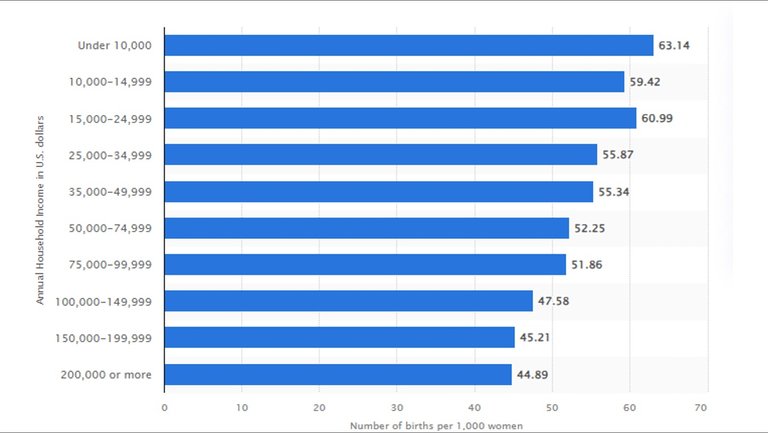
Source: Statista
The inverse relationship between birth rates and income is true for families with a household income below US$500,000 a year. For household incomes above US$500,000, the relationship is reversed. Wealth enables women to have more children. Excessive wealth eliminates many of the barriers to having more children. Any form of childcare is affordable. House size is no longer a limitation. Hired help can take care of all the house chores. Therefore, women can return to work sooner, thus forgoing less income (Quartz). Even if they wanted to take more time off work, the opportunity cost is minimal because of the accumulation of household wealth.
Family Trends
For western countries, the changes in the key determinants of family size appear to be causing families to become smaller. More people live in cities, healthcare has improved, income has increased, and people are moving away from religion.
Household sizes in the US have been consistently declining over the past 50 years. In 1970, more than 20% of households had more than 5 people. In 2022, less than 10% of the population had more than 5 people. The biggest decline in family size occurred in the 1970s and 1980s. Since then, the decline in size has been more gradual. See Figure 2.
Figure 2: Distribution of Households in the US from 1970 to 2022, by Household Size
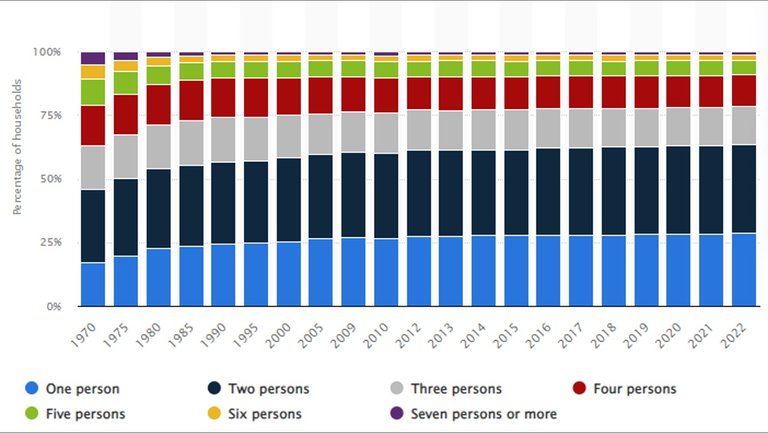
Source: Statista
The decline in household size mostly corresponds with the increase in the number of children raised in single-parent households. However, there has been some divergence over the past decade; this will be discussed later in this section. See Figure 3 for this trend.
Figure 3: Percentage of US Children Living with Both Parents, Mother Only, Father Only, or with No Parent (1968 to 2020)
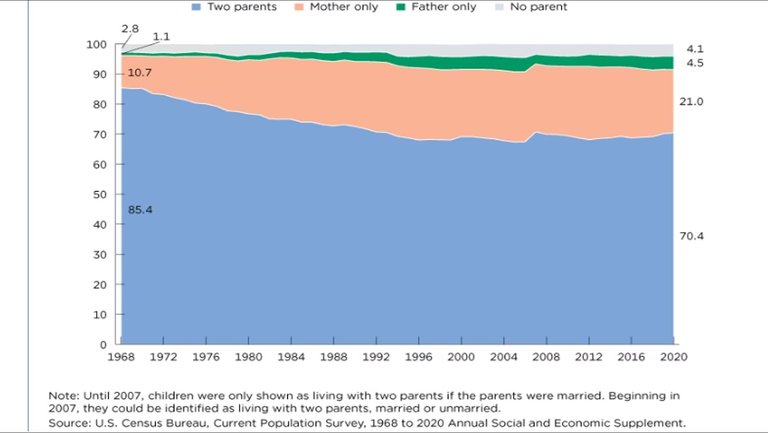
Source: US Census Bureau
Most European countries have also experienced a decline in the size of households. Over a thirteen-year period, on average, the size of European Union households has fallen by around 10%. See Figure 4.
Figure 4: Average Number of People per Household, 2009 and 2022
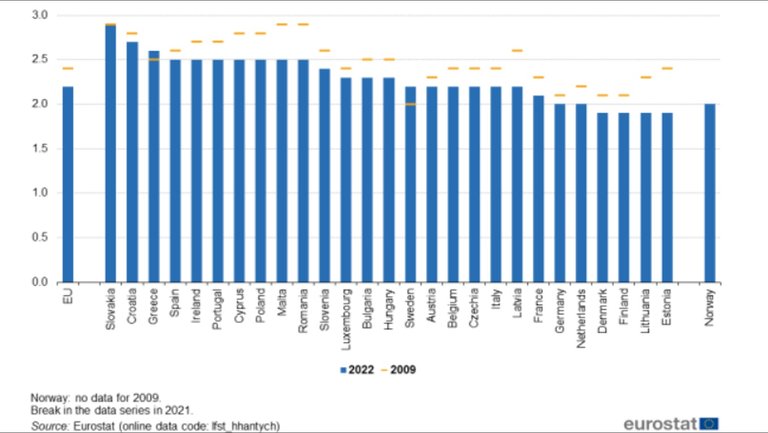
Source: Eurostat
Slight Reversal in the Number of Single Parent Families in the US
Despite the decreasing size of households in the US, the number of single-parent families is declining. This change in trend, which can be vaguely seen in Figure 3, is more apparent in Figure 5, which quantifies the number of single-parent families each year.
Figure 5: Number of Children Living with a Single Mother or a Single Father in the U.S. from 1970 to 2023
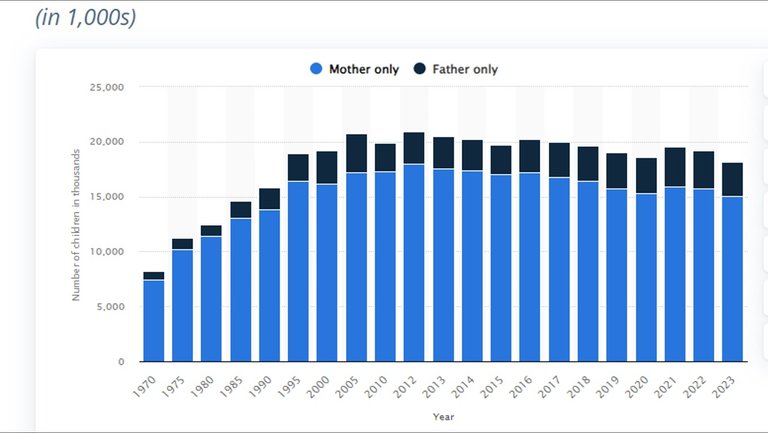
Source: Statista
This appears to be caused by two main factors. Women are having fewer children, and divorce rates in the US are declining. See Figure 6 for trends in fertility rates and Figure 7 for the divorce-to-marriage ratio.
Figure 6: US Historic Total Fertility Rate (1950-2024)

Source: Database Earth
Figure 7: Divorce-to-Marriage Ratio, US (2000-2022)
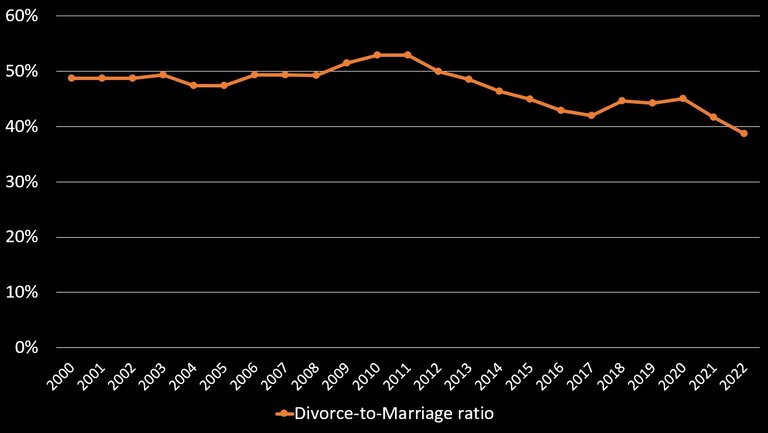
Source: CDC
Both men and women are marrying at an older age. In 2022, the average age for the first marriage for both men and women was about 4 years older than in 1998. See Figure 8 for the ages of both men and women at first marriage.
Figure 8: Estimated Median Age of Americans at their First Wedding in the United States from 1998 to 2022, by Sex
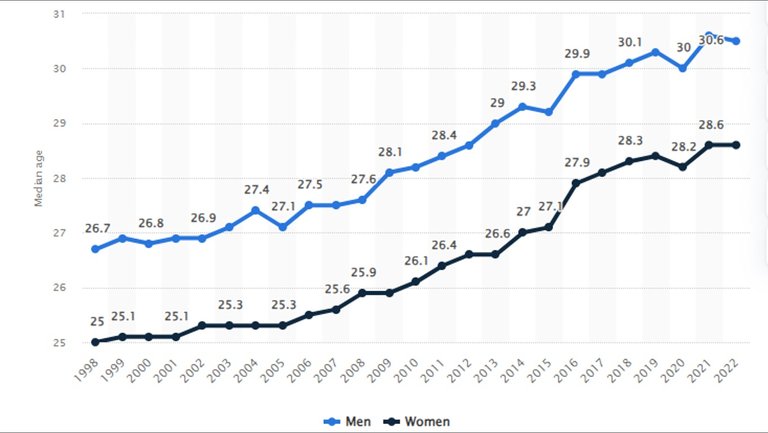
Source: Statista
Later marriages have led to a delay in the birth of the first child. In 2022, the average age at which a woman would give birth to her first child was 2.6 years older than in 1998. The average has been increasing since the mid-1970s; see Figure 9.
Figure 9: Historic Mean Age of Childbearing in the US (1950-2024)

Source: Database Earth
Delaying marriage and delaying the birth of the first child appear to be contributing to lower birth rates. However, this might not be the case. The factors that are causing people to marry later and delay childbearing might be the same factors that are reducing the birth rate. These factors could be higher property prices and a higher cost of living. Young people might choose to stay with their parents longer or move into shared accommodation to reduce costs. This might be a key factor in delaying marriage. These higher costs would also be a key factor in having fewer children.
Delaying marriage might be a reason the divorce-to-marriage ratio is falling. People might make better decisions when they are older. It is also possible that higher costs of living are pressuring people to stay together. Moving out is expensive. It is also possible that the added stress of higher costs of living is adding more pressure on couples to break up. There are many ways different things affect each other.
Figure 10: Possible Relationships between Various Events
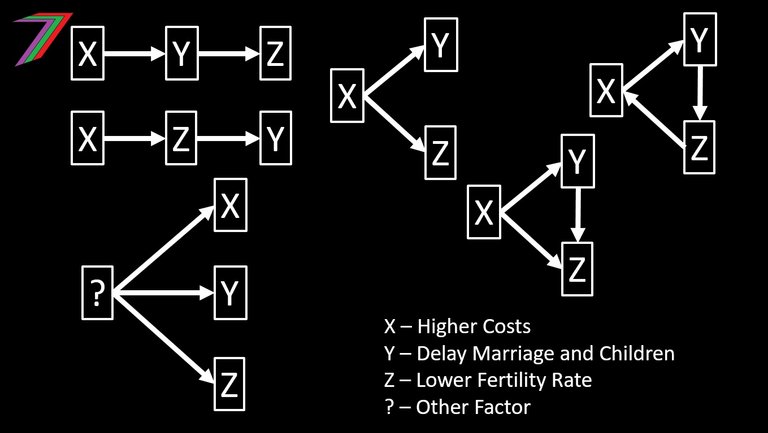
Causation is often difficult to determine. Most events are affected by many other events, and most events affect many other events. In some cases, the relationship can even be circular. Figure 10 offers a few possibilities.
Changing Attitudes Towards Family
The decline in the size of the family is also in line with changes in attitudes regarding the strength of family ties. Based on a 2018 survey of 27 countries conducted by the Pew Research Center, people from 25 countries believed their countries’ family ties were weaker than they were 20 years ago (1998). On average, across the 27 countries, four times as many people believed family ties were weaker than stronger. Figure 11 contains the results for these countries.
Figure 11: How People Around the World View Family Ties in Their Countries
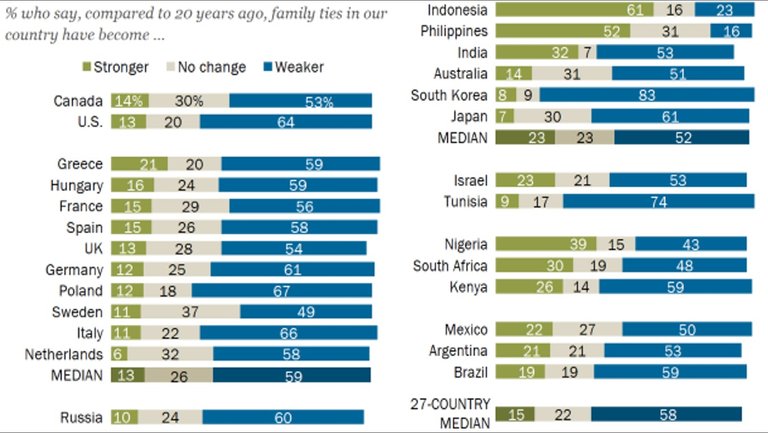
Source: Pew Research Center
Declining Birth Rates are a Major Cause for Concern
The most concerning trend among all of the above is the falling fertility rate. The US is not the only country that is facing rapidly declining fertility rates. Many countries around the world are facing the same problem. The fertility rate needs to be at least 2.1 (replacement rate) to sustain the population in the long run. Table 1 contains the fertility rate per sub-region.
Table 1: Population Fertility Rate by Sub-Region (2024 Projected based on Trends)
| Sub-region | Fertility Rate (births per woman) |
|---|---|
| Australia/New Zealand | 1.6266 |
| Caribbean | 2.0193 |
| Central America | 1.9 |
| Central Asia | 2.8826 |
| Eastern Africa | 4.0855 |
| Eastern Asia | 1.1945 |
| Eastern Europe | 1.5149 |
| Melanesia | 3.0823 |
| Micronesia | 2.7428 |
| Middle Africa | 5.4868 |
| Northern Africa | 2.9895 |
| Northern America | 1.6444 |
| Northern Europe | 1.5894 |
| Polynesia | 2.6032 |
| South America | 1.7901 |
| South-Eastern Asia | 2.1058 |
| Southern Africa | 2.393 |
| Southern Asia | 2.1878 |
| Southern Europe | 1.3393 |
| Western Africa | 4.8172 |
| Western Asia | 2.5413 |
| Western Europe | 1.6262 |
Source: Database Earth
Less than half the countries in the world have fertility rates above the replacement rate of 2.1; most of these countries are from Africa, All European countries are below the replacement rate. Israel is the only OECD country to have a fertility rate (i.e., 2.9) above the replacement rate. Most Asian countries have fertility rates below the replacement rate. This includes the two most populated countries, India (i.e., 2) and China (i.e., 1.2). If we exclude West Asia, the few exceptions in Asia are the Philippines (i.e., 2.7), Laos (i.e., 2.4), and Mongolia (i.e., 2.7).
If the current trends continue, many countries will have a top-heavy population pyramid. There will be more elderly than young people. This will put more pressure on the young to support the old. Many people will need to continue working into old age as retirement ages increase to maintain a sufficiently large workforce.
The Value of Family
Family can come in many shapes and sizes. It could be as large as a tribe or as small as just two people. All or none of them could be related. The most important aspect of a family is its ability to meet the most basic needs of its members. These include security, nurture, love, socialisation, food, support, and comfort.
Traditionally, family has played a vital role in raising children. Human children have the added disadvantage of being born underdeveloped and slow to develop compared with most other species. Therefore, they need more attention during their development. The family should be best positioned to serve that role. If they fail, there is often little to no alternative help.
The breaking up of families has serious consequences for the children. Numerous studies indicate that the breakdown of marriage is strongly correlated with increased mental health and behavioural problems, as well as juvenile crime. See articles: Office of National Programs, the Heritage Foundation, Harbor Mental Helath, D’Onofrio and Emery, and Kroese, J., et al).
Based on 1999 data, the US ranked highest among the higher-income OECD countries for murders committed by youths per million (Nation Master). When compared with other high-income countries, the US had and still has a relatively high percentage of children living in single parent homes (Pew Research Center for percentage of children living in single parent households (2010 to 2018) and Our World in Data for percentage of single parent households in 2000).
Figure 12: Percentage of Children Living in Single Parent Households Around the World
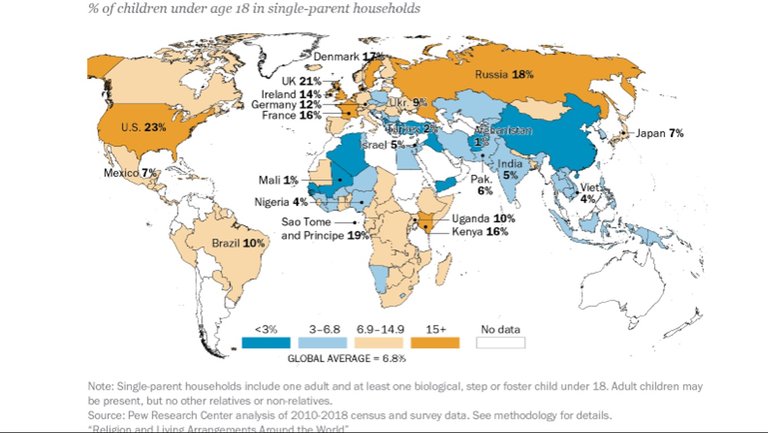
Source: Pew Research Center
In the 2000’s, in the US, the number of violent crimes committed by juveniles decreased substantially (Statista).
Figure 13: Number of serious violent crimes committed by youth aged between 12 and 17 years in the U.S. from 1980 to 2021

Source: Statista
Illegal drug use has also fallen significantly among teenagers. In the mid-1990s to early 2000s, over 40% of teenagers used illicit drugs, in the early 2020s; this has been reduced to less than 30%. See Figure 14.
Figure 14: Lifetime prevalence of use of any illicit drug for grades 8, 10, and 12 combined from 1991 to 2022

Source: Statista
Note: Data Presented from Right to Left
The decrease in violent crimes committed and reduced drug usage is a positive sign. However, these numbers are still very high compared to the rest of the world and other demographics (Statista).
Data indicates that the mental health of children in the US is in sharp decline. Approximately 1 in 3 teenagers suffer from anxiety, and approximately 1 in 7 suffer from depression. It is possible the increase could be due to increased reporting of mental illness, but suicide rates have also increased sharply for children, teenagers, and young adults. See Figure 15 for the suicide rates of youths for 2000 and 2017.
Figure 15: Suicide Rates Increased Among Youth, Teens, and Young Adults from 2000 - 2017
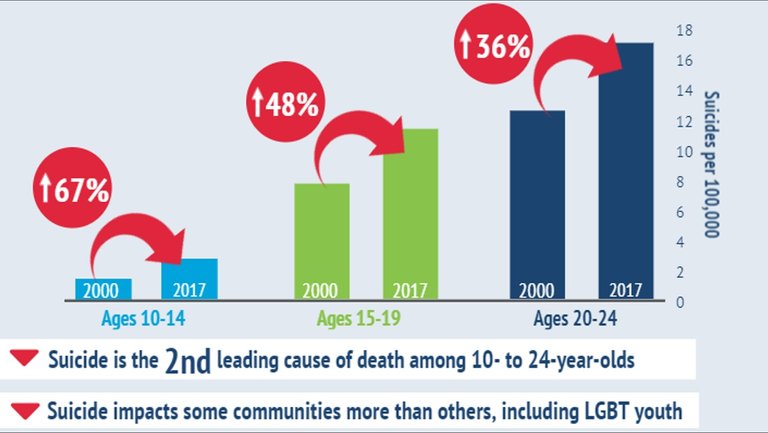
Source: NIHCM Foundation
The suicide rates of children in most European countries are also high. It is now the second-leading cause of death of 15 to 19 year olds behind road accidents (UNICEF). Figure 16 contains the suicide rate for European countries.
Figure 16: Suicide Rate Among the 15-19 Year-Olds, 3-Year Average, 2015-17 (or nearest years)
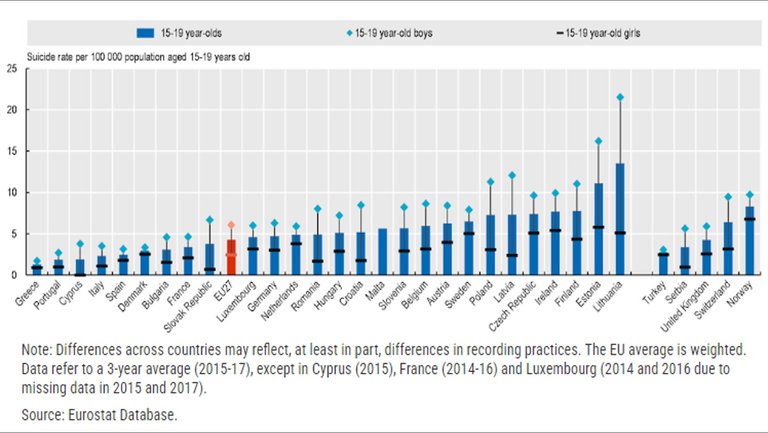
Source: OECD
Lithuania and Estonia stand out above the other countries with suicide rates of 14 and 11 per hundred thousand 15 to 19 year olds, respectively. This is similar to the US for this age group. Estonia and Lithuania also have the smallest average family size (1.9 family members) of these European countries. Greece had the lowest suicide rates and had one of the largest average family sizes (2.6 family members). See Figure 4 for comparisons.
Smaller family sizes place the responsibility of raising children on fewer family members. There is less support from grandparents and fewer older siblings to help them out.
Data from various sources indicates that parents have greatly increased the amount of time they spend with their children (marriage.com and Pew Research Center). Figure 17 shows the trends in parents time spent with their children.
Figure 17: Amount of Time Parents Spend with Children per Day
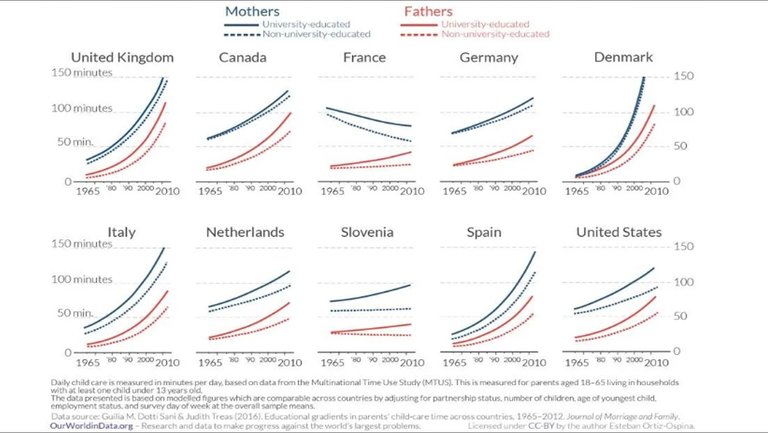
Source: Our World in Data, cited by Financial Samurai
Another interesting statistic to consider is labour force participation rates. Large families with retired grandparents enable working age parents to work or work longer hours. The US labour participation rate has been declining since the mid-1990s, as can be seen in Figure 18.
Figure 18: US Labour Force Participation Rate
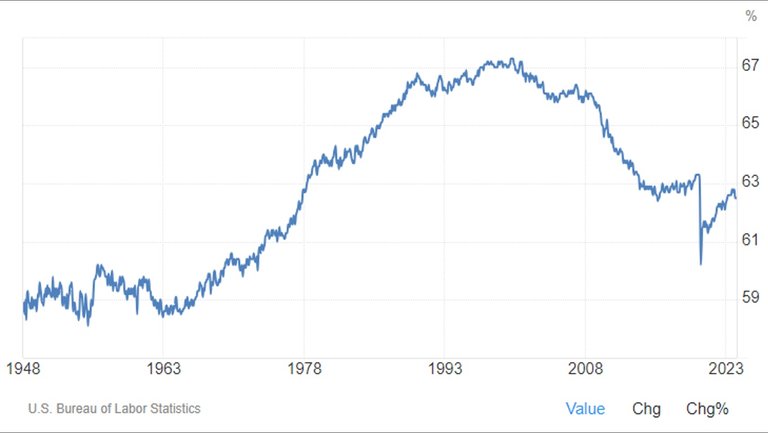
Source: Trading Economics
Figure 18 is a little deceptive. The labour force participation rate is not declining because people are choosing to work less. It is declining because of the ageing population. Labour participation rates are increasing for every age group. The overall decline is caused by more people being in the older age groups, which naturally have a lower participation rate (US Census Bureau).
Labour force participation rates have continued to increase across the Eurozone despite the ageing populations of these countries. Figure 19 contains the Eurozone labour force participation rate, and Figure 20 contains the population by age for Europe.
Figure 19: Eurozone Labour Force Participation Rate

Source: Trading Economics
Figure 20: Population by Age Group, Europe (UN)

Source: Our World in Data
The combination of smaller families and higher labour participation is a bad combination for raising children. Parents have less support and less time to raise their children sufficiently. Under these circumstances, not having children is a better option for couples. On top of that, almost every other factor affecting family size is pushing people towards having fewer children. The decline we are seeing was almost inevitable.
Intentional or Unintentional

Is the decline in the family intentional or unintentional? Many of the reasons for the decline in family have occurred naturally. These include the higher costs of properties in urban areas, the higher cost of raising children, and moving away from religious practices. However, many others have been induced.
Government policies are designed to favour large businesses. Therefore, people are forced into employment instead of being able to run their own businesses (self-employment is more conducive for families; discussed earlier in the post).
Women have been pressured and manipulated to participate in the workforce as employees. Propaganda has been used to undervalue the importance of work inside the home. This has become a problem because of the reduced size of the family and the unwillingness of men to adjust their roles. The adults of the family should work together to ensure all aspects of the family are adequately taken care of.
Smaller families are more vulnerable than larger families. There are fewer people to ensure that it can perform all its necessary functions. This becomes even more difficult when it is confronted with external threats. One of the biggest threats is social media.
In 2019, in the US, more than half of children aged 11 owned a smartphone, and 84% of teenagers owned smartphones (NPR). These devices enable children to have almost unlimited access to social media. Access to more information is good if the person accessing it has the ability to understand and analyse the information they are exposed to. Most children lack this ability because they have not been taught to think for themselves. Therefore, social media has become a tool to manipulate children. Social media algorithms are used to target children with potentially harmful ideologies. The biggest threat is woke ideology.
There are many aspects of woke ideology that are harmful to children and a threat to families and family values. The two biggest threats are ‘anti-racism’ and transgender ideology.
‘Anti-racism’ ideology is a form of racism. It is designed to segregate people based on skin colour. People of mostly European decent are referred to as ‘White’ and people of African descent are referred to as ‘Black’. Both terms are racial slurs that have become normalised.
The children categorised as ‘White’ are taught to self-loathe because of their privilege. The children categorised as ‘Black’ are taught they will always face discrimination and will always be the victims. Both positions are destructive as they damage self-esteem. It is quite possible that the rapidly increasing suicide rates for both ‘White' and ‘Black’ children (Inserro, A.) are being accelerated by this demoralising ideology. Read my posts ‘Global Collapse – Part 5B: Global Civil War’, section: Black and White War and ‘The Great Word Play’, section: Black and White Divide.
Transgender ideology is deliberately designed to confuse. It begins with the terminology. Traditionally, the words ‘gender’ and ‘sex’ were used interchangeably. The definition of gender has been changed to refer to social constructs for male and female roles. This change in definition is strongly contested by a large proportion of society. This definition of gender is not applied universally across all terminology relating to gender. For example, gender dysphoria could refer to a conflict between gender identity and gender or gender identity and sex.
Children are being taught that gender can be fluid. Based on this new definition, that is possible. However, they are also taught that changing gender needs to mimic changing sex. Boys can become girls, and girls can become boys. Any child that does follow the typical gender stereotypes can be targeted. They are told to dress differently, identify themselves using different pronouns, and change their name to align with their new gender. This can then lead to the use of life altering drugs that block natural puberty, hormones to change appearance, and even irreversible surgery.
Figure 21 contains the staggering increase in gender dysphoria diagnosis, use of puberty blockers, hormone treatment, and surgery for children aged between 6 and 17 in the US.
Figure 21: Gender Dysphoria Diagnoses, Use of Puberty Blockers, Hormone Treatment, and Surgery
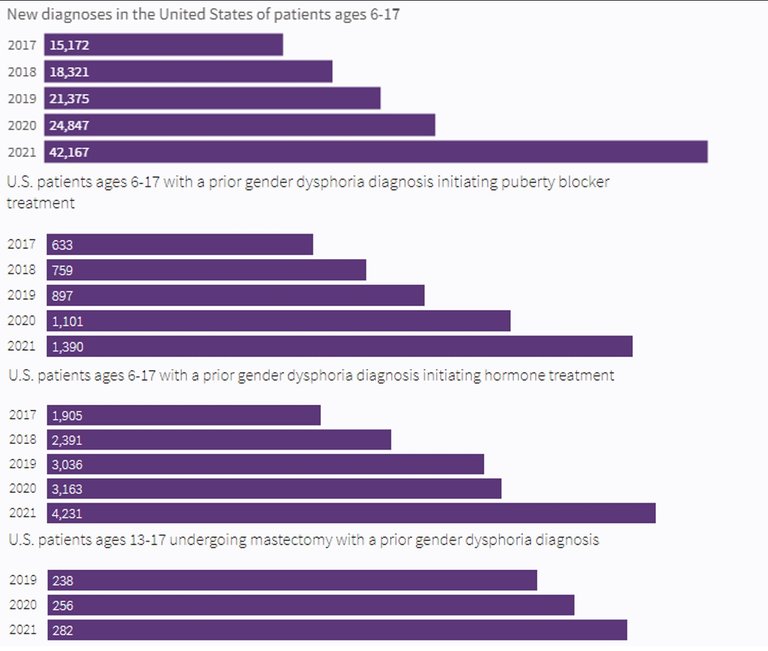
Source: Reuters
Social media reinforces these dangerous ideologies, but many children are being introduced to them by schools, mainstream media, and even parents. Some parents honestly believe they are helping their children by exposing them to this ideology. They create their child’s delusion, or they reinforce the delusion imposed on them elsewhere, such as in school. Some parents might be more opportunistic and use this ideology to ‘change’ their child’s sex to one they would prefer. Read my posts ‘The Subjugation of Femininity and the Mirage of Sex Equality (Part 1: Definitions and the Illusion)’, section: ‘Gender vs. Sex’ and ‘The Subjugation of Femininity and the Mirage of Sex Equality’(Part 3: My Opinions), section: ‘Gender and Sex Diverged’ for a broader discussion on transgender ideology.
During the Covid-19 fiasco, from early 2020 until the end of 2022, schools around the world were subject to closures or some other forms of restrictions (Our World in Data). Figure 22 contains the number of weeks of school closures in each country.
Figure 22: Covid-19 School Closures by Number of Weeks by Country
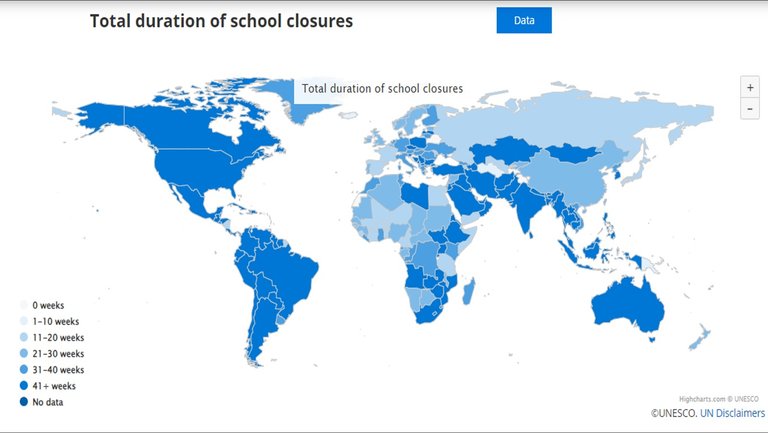
Source: UNESCO
We could strongly argue that schools do not do a good job of offering our children a well-rounded education. Therefore, missing time in school might not be a huge cost to them in terms of learning. However, the closures imposed a huge cost in terms of disruption to everyday life. The school was replaced by a void, as there was no planned replacement. Children became bored from a lack of planned activity. They became stressed and anxious regarding uncertainty about their future (Save the Children). For example, how would they handle school when they finally returned? Children’s mental health was already in decline, the lockdowns and restrictions have almost certainly added to this problem.
After the lockdowns, many countries forced restrictions on children within schools; these would include social distancing and wearing masks. These measures affected how children socialised and, in some cases, might have harmed them both physically and mentally (Conservative Firing Line). On top of these restrictions, some schools even forced children to be given the Covid-19 jab, even though these jabs offered no benefit to the children themselves. However, they posed plenty of risks.
Motivation for Destroying the Family and Children

Would the Establishment (i.e., Government, Media, Religion, Banking, and Big Business) prefer us to have smaller or larger families? Would they prefer functional or dysfunctional families? Families shape young people. Young people will eventually shape society. The destruction of the family could lead to the destruction of society. If families can no longer play this critical role, this role could be taken over by someone else. This is likely to be the state.
For the youngest children, this can be done by offering free or subsidized day care. In 2024, the UK will have expanded the availability and hours for free childcare (UK Government). For older children, this can be done by extending school hours or including more extra-curricular activities. For example, school hours could be extended to 9 to 5 in some US States (Public School Review). In 2021, the US Government announced the American Families Plan. The plan proposes a wide range of Government support for children across all ages (The White House).
They could easily claim that their expanded role was necessary for the benefit of society as a whole. Considering how bad circumstances have become in regards to young people’s mental health as well as the declining birth rates, many would support their invention. It would take pressure off busy parents. It would also encourage more couples to have children, as it would save them time and money. Statistically, things would likely improve. Thus, these initiatives would maintain support.
The Establishment would benefit the most from greater state intervention in childcare and education. They would more easily be able to dictate ideology to children. Parents would have less say and influence over their children’s beliefs. Eventually, when these children become adults, they will voluntarily promote Establishment ideology to their own young.
The smaller nuclear family structure would ensure children had limited contact with their grandparents. The growth of 15-minute cities may further increase the divide between children and their grandparents, as visits could become less frequent due to imposed travel constraints. In Chapter 72: Maintaining Control of my fictional book, Sapien Loop, I discuss how power can be maintained by breaking up the family.
My New Book, Sapien Loop

I have published an ebook on Amazon; it is titled ‘Sapien Loop: End of an Era’. The book is fiction. I do not normally write fiction. However, I felt it was appropriate considering what is happening in the world today. Freedom is the most important thing we have, but we are gradually losing it. I have covered this in many of my posts.
In the story, most citizens do not understand the concept of freedom because they have never really experienced it. In essence, the story is about an alien world that might represent our not-so-distant future. There are many other elements to the story that are an abstract and exaggerated version of our reality. I believe this book to be an important read, and I believe it has the potential to change the way you think.
Brief Summary of Sapien Lopp

This story is based on the fictional planet Sapia and its sole country, Sapey. Sapey is portrayed as a form of utopia for all its citizens. No poverty. No war. Almost no crime. Opportunities for all.
This was enough for most citizens, but not all. In one of the small regions, some of the citizens had become discontent. They felt something important was missing in their lives. Their discontent did not go unnoticed. Some of the Sapey elite wanted to weaponise this discontent to gain more power. This created more chaos than they anticipated. This led to further widespread social unrest.
On top of the chaos, ambition and greed provoked another enemy. This enemy was on a mission to settle both new and old scores.
If you want to buy a copy of the book, below are links to the relevant Amazon websites for each country it is available in. The book is priced at approximately US$5.08.
- Amazon USA
- Amazon UK
- Amazon Germany
- Amazon France
- Amazon Spain
- Amazon Italy
- Amazon Netherlands
- Amazon Japan
- Amazon Brazil
- Amazon Canada
- Amazon Mexico
- Amazon Australia
- Amazon India
I am also running monthly contests where participants are required to answer questions based on the book. The prize is 30 Hive Power plus upvotes for the first twelve entries. You can recover the cost of the book with just one win.
Hive: Future of Social Media

Spectrumecons on the Hive blockchain

Families is a factor that play a crucial role in the way some people lives play out. In fact I will say it goes a long way in that aspect. Just as you stated, culture plays a crucial role in the structure of family. No matter what family is very key and we must be very careful that in the society, we set huge standard around to make sure it still hold on it's importance.
Do you know that there are people who no longer believe in families any longer probably due to what they have experienced
Part of the problem is the conflict between conservative and liberal values. Conservatives strongly support family values and maintaining traditional family structures. Liberals want to explore new ideas and different ways of living life.
Exploring different things is great for improving life. However, anything new needs to be assessed against the status quo. If it is an improvement, it should be pursued; if it is not, then it shouldn't be. There does not seem to be a good alternative to family. However, the family structure could be changed and still serve its main purposes.
As always your charts are numerous 😂😂😂
At first when I saw the title of Family, I thought I would see a moving emotional post of the spectrumecons...
Families; the decline, startup and advantages is a lengthy topic in all ways.
Especially now when they are started sporadically and ending even more suddenly.
The children left behind, how they turn out and become the new generation is a sour topic.
The children who aren't left behind, yet the new unplanned family (mostly teenagers) is struggling for scraps to try and feed themselves and a child in such inflated times.
Many thoughts about a family, yet the main truth is simple.
A family should be planned, not something done on a whim or with a flimsy excuse.
There has been quite a shift in terms of how the family is prioritised. It used to be central to everyone's life. Our lives were built around our family. Family has taken a secondary role to personal pursuits. For example, career or pleasure. Sadly, those most dependent on family end up paying the price; children and the elderly.
Wow, that is a lot of data. It is very concerning that we are seeing declining birthrates worldwide. Japan and South Korea seems to have some of the lowest rates. I have read issues where family businesses are forced to close because they don't have enough children to pass it on to, or the children have moved to cities. I think a lot of people still value families, and would want to start one, but the biggest hindrance has been the cost of living. Some would even argue the state of the world is messed up and they wouldn't want a child to experience it.
There are so many things working against the family. It is difficult and expensive to grow. However, it is also incredibly important. Broken families lead to broken people.
Definitely a great overview, kudos for that!
I have traveled to several continents and can confirm myself that the term 'family' is indeed everywhere different. The way how people look at it, how they look at their grandparents and taki'g care for them, etc etc.
Thanks for sharing!
Family is incredibly natural to us. Different cultures around the world promote the importance of family. The structures of these family can vary significantly but they all fill similar roles and are essential to the most vulnerable.
Congratulations @spectrumecons! You have completed the following achievement on the Hive blockchain And have been rewarded with New badge(s)
Your next target is to reach 105000 upvotes.
You can view your badges on your board and compare yourself to others in the Ranking
If you no longer want to receive notifications, reply to this comment with the word
STOPCheck out our last posts:
This post has been manually curated by @steemflow from Indiaunited community. Join us on our Discord Server.
Do you know that you can earn a passive income by delegating to @indiaunited. We share more than 100 % of the curation rewards with the delegators in the form of IUC tokens. HP delegators and IUC token holders also get upto 20% additional vote weight.
Here are some handy links for delegations: 100HP, 250HP, 500HP, 1000HP.
100% of the rewards from this comment goes to the curator for their manual curation efforts. Please encourage the curator @steemflow by upvoting this comment and support the community by voting the posts made by @indiaunited.